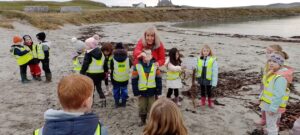Building Nocturnal Homes: A STEM Adventure in P2
Last week, Primary 2 embarked on an exciting STEM challenge to design and create nocturnal animal dens! With teamwork, creativity, and a whole lot of imagination, the children used their engineering skills to build cozy homes for their chosen animals—complete with some unexpected luxuries like TVs and hot tubs!
Designing with Care
The challenge began with some big questions: What makes a good home for a nocturnal animal? and How can we build it using the materials we have? Working in small groups, the children chose their animals—badger, fox, owl, or hedgehog—and got to work sketching their designs.
- “A hedgehog’s house needs lots of leaves to stay warm”
- “Our fox needs a secret tunnel to hide”
The children carefully thought about the needs of their animals, considering shelter, safety, and comfort, all while showing off their critical thinking and problem-solving skills.
Creating with Junk
With their designs ready, it was time to build! Armed with junk materials like cardboard boxes, bottles, paper, and string, the groups brought their designs to life. The classroom buzzed with excitement as everyone worked together, using their meta-skills:
- Cate the Collaborator helped them share ideas and work as a team.
- Focusing Fergus kept everyone on track, even when things got tricky.
- Critical Thinking Chris inspired them to problem-solve when parts of their designs didn’t go as planned.
The results were nothing short of spectacular!
- The owl’s home had a cosy corner for resting and reflective tape so it could fly in and out of its home.
- The badger’s den featured a television!
- The fox’s den had a clever tunnel entrance and a hot tub.
- The hedgehog’s house was packed with leaves and even had an extra space for the baby.
Sharing Our Creations
Once the homes were complete, each group presented their work to the class, explaining how their design met the needs of their nocturnal animal. The presentations showcased not only their creativity but also their growing confidence in speaking to an audience.
The children loved hearing about each other’s designs, and the variety of ideas sparked even more creativity!
The Aftermath
By the end of the session, the classroom was a total mess—but they children enjoyed themselves and ended the lesson with a smile on their faces.
What We Learned
This STEM challenge gave the children a chance to:
- Apply their understanding of nocturnal animals and their habitats.
- Use design thinking to solve real-world problems.
- Develop collaboration, focus, and critical thinking skills through teamwork.
Next Steps
Inspired by the success of this project, the children are already asking what we can build next! Maybe a rocket for exploring the stars or a bridge for animals to cross safely?





